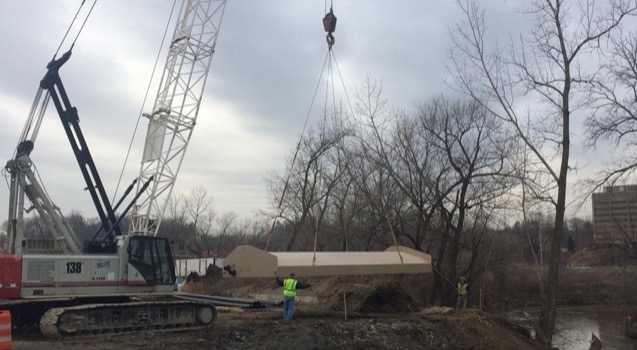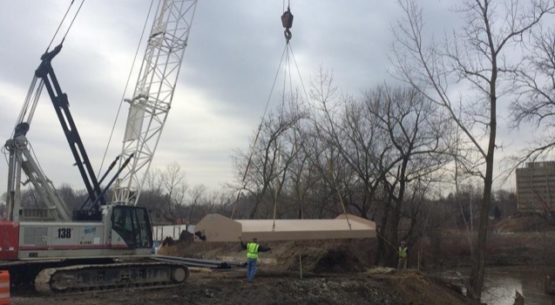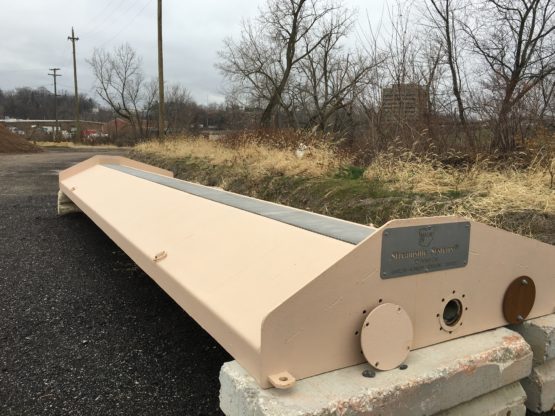Cuyahoga River – Independence, Ohio
The Bedload Sediment Collector, often referred to as (Bedload Interceptor), for the Cuyahoga River became a reality for Streamside, LLC because of collaborative efforts from the Cleveland-Cuyahoga County Port Authority, Streamside Environmental, LLC, Kurtz Bros. Inc., CH2M Hill, Foth Infrastructure, Great Lakes Construction, and many other organizations with funding and support from Ohio’s Healthy Lake Erie Fund, Ohio EPA and Ohio DNR.
The 30-foot wide Bedload Sediment Collector selectively collects sediment migrating at the bottom of the river as bedload once it falls through its sized grates and into its hopper. The Sediment Collector is directly connected to a submersible pump in a dry well along the shore where it pumps the sediment slurry collected in the Sediment Collector to a feed box above a fine-material screw separator on shore. The separator dewaters the sediment and drops it onto a stacker conveyor for stockpiling for beneficial reuse of the collected material
The installation of the Bedload Collector on the Cuyahoga River was originally a large-scale pilot to prove concept and scalability, and after initial term of the pilot, the 30-foot collector system has been turned over to a private organization with partnership to continue operating and running the system for beneficial reuse.
The operation of the Bedload Sediment Collector commenced in the summer of 2015 with intermittent operation due to fluctuation in river conditions and climate in Northeast Ohio. The system shuts down and is winterized under freezing temperatures and is restarted in the spring for runoff and warmer weather. The system also operates intermitently based on the flow of the river in relevance to the sediment load migrating based on the flow, (when minimal to no flow the collector cycles with long delays, whereas when the river is at flood stage with high flow rates, the collector operates continuous).
According to the Port Authority, “the U.S. Army Corps of Engineers is responsible for seeing that the channel is dredged and while it costs the federal agency $17 per cubic yard to dredge sediment from the shipping channel, it only costs about $1 per cubic yard to collect sediment in the interceptor.”
Gallery
The Bedload Sediment Collector, often referred to as (Bedload Interceptor), for the Cuyahoga River became a reality for Streamside, LLC because of collaborative efforts from the Cleveland-Cuyahoga County Port Authority, Streamside Environmental, LLC, Kurtz Bros. Inc., CH2M Hill, Foth Infrastructure, Great Lakes Construction, and many other organizations with funding and support from Ohio’s Healthy Lake Erie Fund, Ohio EPA and Ohio DNR.
The 30-foot wide Bedload Sediment Collector selectively collects sediment migrating at the bottom of the river as bedload once it falls through its sized grates and into its hopper. The Sediment Collector is directly connected to a submersible pump in a dry well along the shore where it pumps the sediment slurry collected in the Sediment Collector to a feed box above a fine-material screw separator on shore. The separator dewaters the sediment and drops it onto a stacker conveyor for stockpiling for beneficial reuse of the collected material
The installation of the Bedload Collector on the Cuyahoga River was originally a large-scale pilot to prove concept and scalability, and after initial term of the pilot, the 30-foot collector system has been turned over to a private organization with partnership to continue operating and running the system for beneficial reuse.
The operation of the Bedload Sediment Collector commenced in the summer of 2015 with intermittent operation due to fluctuation in river conditions and climate in Northeast Ohio. The system shuts down and is winterized under freezing temperatures and is restarted in the spring for runoff and warmer weather. The system also operates intermitently based on the flow of the river in relevance to the sediment load migrating based on the flow, (when minimal to no flow the collector cycles with long delays, whereas when the river is at flood stage with high flow rates, the collector operates continuous).
According to the Port Authority, “the U.S. Army Corps of Engineers is responsible for seeing that the channel is dredged and while it costs the federal agency $17 per cubic yard to dredge sediment from the shipping channel, it only costs about $1 per cubic yard to collect sediment in the interceptor.”



